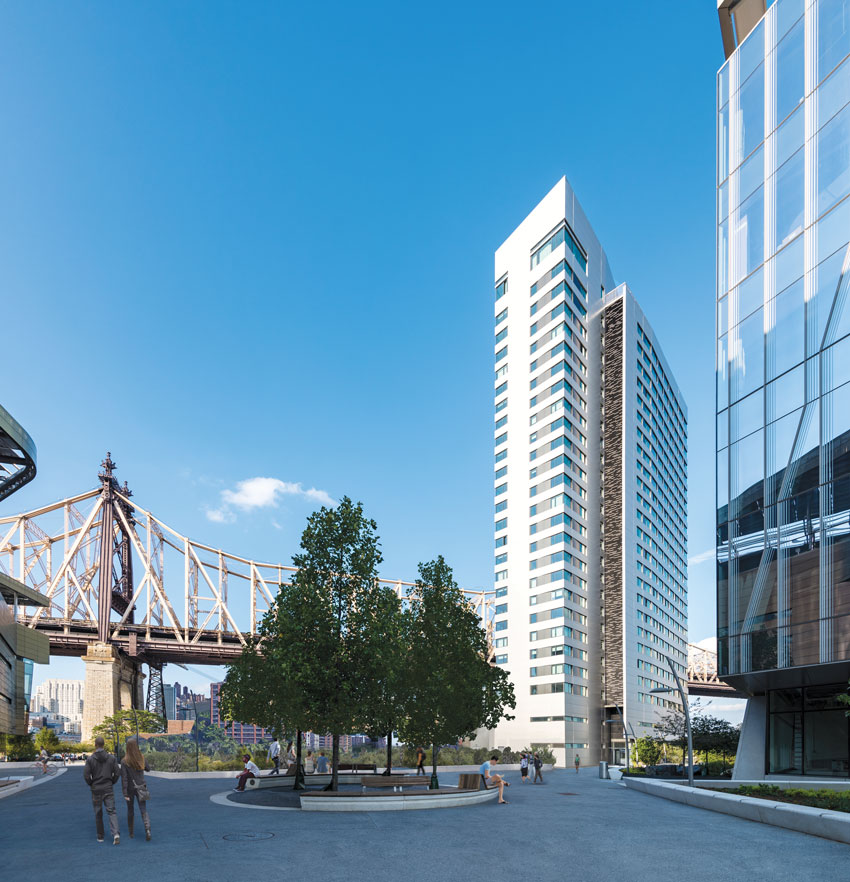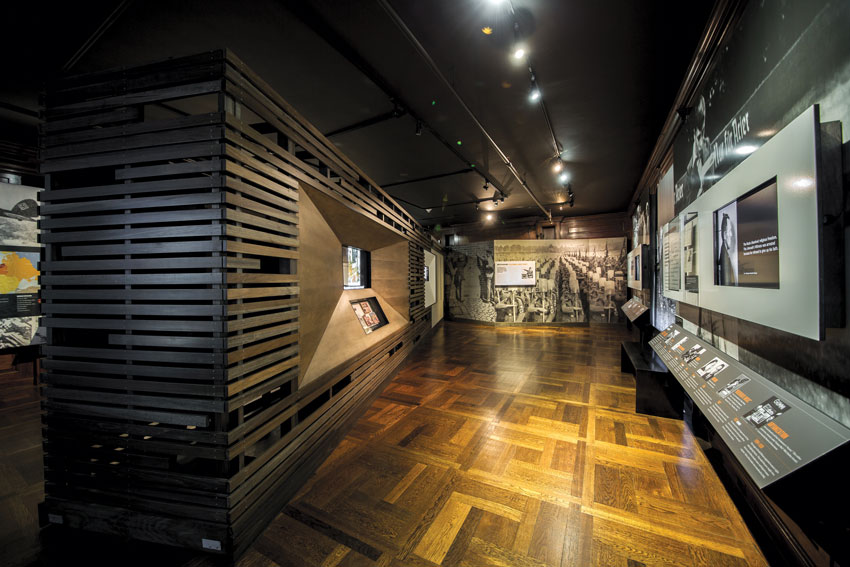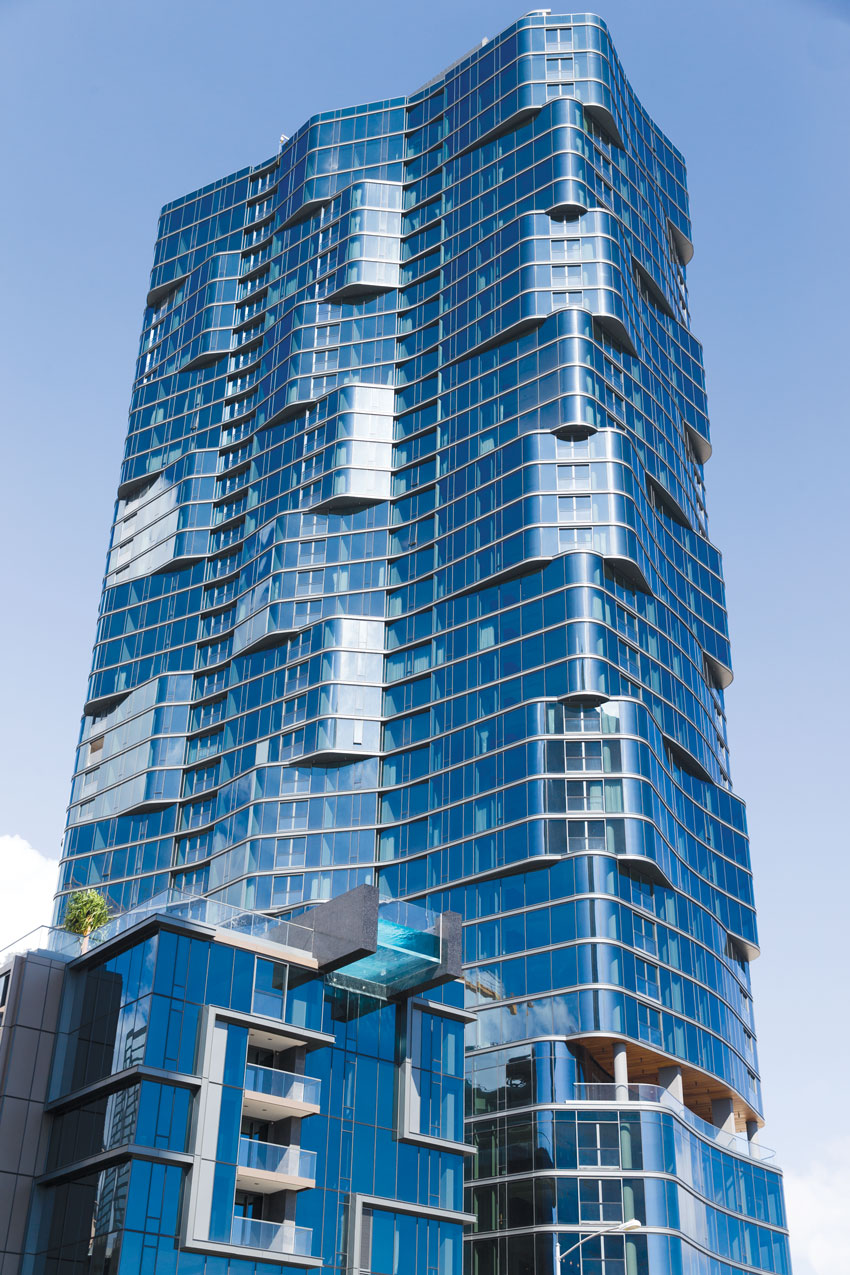Sustainability Without Compromise
Insulating The House at Cornell Tech to Achieve Passive House Certification
The House at Cornell Tech (The House) is a 26-story residential high-rise for students, staff, and faculty situated on Roosevelt Island in New York City designed by Handel Architects and Steven Winter Associates. Architecturally, this project is notable because when it was built, it was the world’s tallest building to earn certification from the rigorous Passive House international building standard. It has earned LEED Platinum status as well.
The Passive House building standard uses passive design principles to dramatically reduce the amount of energy necessary to heat and cool an interior to keep it comfortable. In short, the standard emphasizes the importance of proper insulation, proper windows, and the elimination of air leakages that enable hot air and heat energy to leave a building. More specifically, a passive building employs continuous insulation throughout its entire envelope to minimize thermal bridging. The building envelope is airtight, preventing infiltration of outside air and the loss of tempered air. Windows and doors are high performance, thermally broken, and triple glazed. There is often some form of balanced heat and moisture-recovery ventilation and a minimal space conditioning system. Buildings are oriented to maximize solar gain in the winter and minimize it in the summer. The impact of these passive measures on HVAC energy use is nothing short of astounding. Buildings built in compliance with the Passive House standard can reduce their demand for heating and cooling energy by up to 90 percent.

Photo courtesy of Handel Architects
The House at Cornell Tech earned certification from the rigorous Passive House building standard as well as LEED Platinum status.
High-quality insulation is critical to designing a successful passive construction project. Creating the well-insulated thermal envelope that helped The House to surpass the aggressive thermal performance criteria of the Passive House standard required semi-rigid stone wool insulation boards 280 millimeters (11 inches) thick in the exterior wall cavity. Lightweight, semi-rigid stone wool batt insulation was specified into the steel-stud interior wall and floor. Multipurpose stone wool boards were also incorporated into the walls, ceilings, and floors of the project. “The building envelope was constructed to exacting standards,” explains Debra Moelis, AIA, PHCD, senior associate, Handel Architects. “To achieve the necessary level of efficiency and thermal performance, new products, procedures, and innovative details were incorporated, including continuous insulation, overlapping vapor barriers, meticulous taping methods, and thermal separation of metals. Extensive, specialized training ensured that the installation and sealing were carried out with precision.”
Every structure that earns Passive House certification must pass a stringent on-site pressure test that ensures that these buildings are sealed airtight, with no leaky windows or building joints, making it possible for them to preserve indoor temperatures. Moelis notes that the building “heroically passed the notably difficult Passive House blower door test, with results that were four times better than required.”
The House became Passive House certified in the autumn of 2017, and it is estimated that this residential structure will save 882 tons of CO2 emissions per year, which is the equivalent of planting 5,300 new trees.
Lighting the Holocaust Memorial and Tolerance Center of Nassau County
The Holocaust Memorial and Tolerance Center of Nassau County in New York is tucked inside the Welwyn Preserve in Glen Cove. It was the first Holocaust museum and educational center to serve the nearly 3 million people on Long Island. In 2014, a $1-million renovation was completed, launching The Claire Friedlander Education Institute and dramatically improving the operation of the existing museum facility.
During the renovation, the lighting in the museum was replaced with architectural LED fixtures, including wall washers and monopoints. The lighting upgrade has resulted in several important benefits, including energy savings, simplified maintenance, and more flexible light placement. “With the new lighting, the lobby is now bright and inviting. It gives you a sense that you are in a space of deep history and knowledge,” explains Helen Turner, education director at the Holocaust Memorial and Tolerance Center of Nassau County.

Photo courtesy of WAC Lighting
During a renovation, the lighting in the Holocaust Memorial and Tolerance Center of Nassau County was replaced with architectural LED fixtures, including wall washers and monopoints.
“Before the renovation, we spent a lot of time and money replacing lightbulbs. With the new lighting, we are saving a lot of money, which is very nice,” Turner says. The architectural LED lighting selected for the Holocaust Memorial features proprietary drivers and LED modules that have been rigorously tested to perform longer than other products over their usable life. For example, both the monopoints and wall wash fixtures installed onto this project have a rated life of 50,000 hours, which means they could be left on for almost six years before the LED modules would need to be replaced.
The new lighting also improved the versatility of the museum space. “The new lights are very mobile. You can turn and angle them, put them up or down, and this flexibility can really change the feel of an exhibition,” Turner explains. The adjustability of the fixtures enable museum personnel to tailor the beam angle and directionality of the throw to precisely match the needs of each unique display.
“Beyond the beautiful and energy-efficient fixtures, we chose these lighting fixtures because of the ethics behind the lighting company,” Turner continues. “I think we have very similar missions to make the world a better place.”
The Glass Cladding on Anaha Tower Balances Beauty, Performance, and Sustainability
The Anaha Tower in Honolulu, Hawaii, is a luxury, 40-story, 311-unit residential building in the most distinguished urban neighborhood on O’ahu. Designed by Chicago-based architect Solomon Cordwell Buenz (SCB) in partnership with Hawaiian firm Benjamin Woo Architects, this LEED Silver-certified project features a high-performance, undulating curtain-wall facade. This distinct and beautiful blue-green glass cladding also manages solar energy with a superior level of precision, resulting in energy performance capable of attaining impressive sustainable design certifications.
“The Hawaiian name Anaha translates to mean the reflection of light,” explains Strachan Forgan, principal at SCB. “Abstractions of waves are common in the island’s artistic traditions. The tower’s shape is derived from a sequence of softly curved floor plates, wrapped in a smooth glass skin. The composition is reminiscent of the play between the crests and troughs of a calm ocean wave. Like a wave, the reflection of light off the facade will constantly alter as the viewpoint and environmental conditions change.”

© Marco Garcia
The high-performance glass cladding selected for the Anaha Tower in Hawaii could be radiused in large pieces, without optical distortion, and met important solar performance metrics in terms of glare control and solar heat gain management.
The Anaha Tower is clad in 275,000 square feet of glass, 20,000 square feet of which is curved glass, also referred to as bent glass. “In order for the design concept to be successfully executed, it was important that the alternating glass forms be read as soft and interlocking,” Forgan continues. “This was achieved by using true radiused insulated units and not faceting the windows at the corners. Selecting a high-performance coated glass that could be radiused in large pieces, without optical distortion, was a key technical decision in support of the design.”
The functional performance of the glassc facade had to balance the ability to maximize the amount of beautiful Hawaiian light allowed into the residences, while preventing glare and solar heat gain from causing discomfort and spiking energy bills. Ultimately, the glass specified into the curtain wall provided enhanced solar control that allowed residents to comfortably enjoy their stunning views with minimal deployment of shades.
“The glass we selected for the Anaha Tower project featured the only coating on the market that could be bent and meet the solar management performance criteria, in terms of solar heat gain control and visible light transmission, required by the energy requirements,” Forgan says.
These four projects showcase that sustainability no longer requires compromise when the right solutions are selected. Keep reading for more information on the systems that helped the designers of the featured projects achieve their multifaceted goals.
Notice

www.guardianglass.com

MitsubishiPro.com

www.rockwool.com

www.waclighting.com









